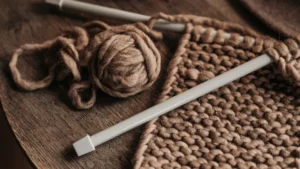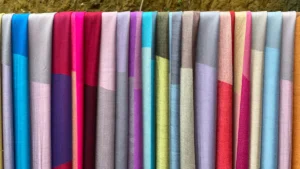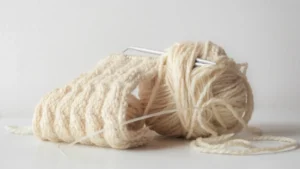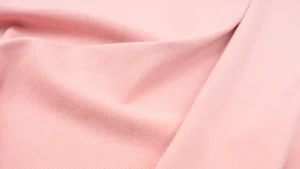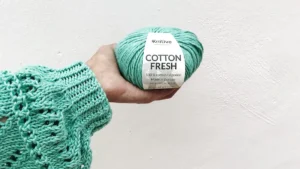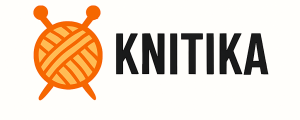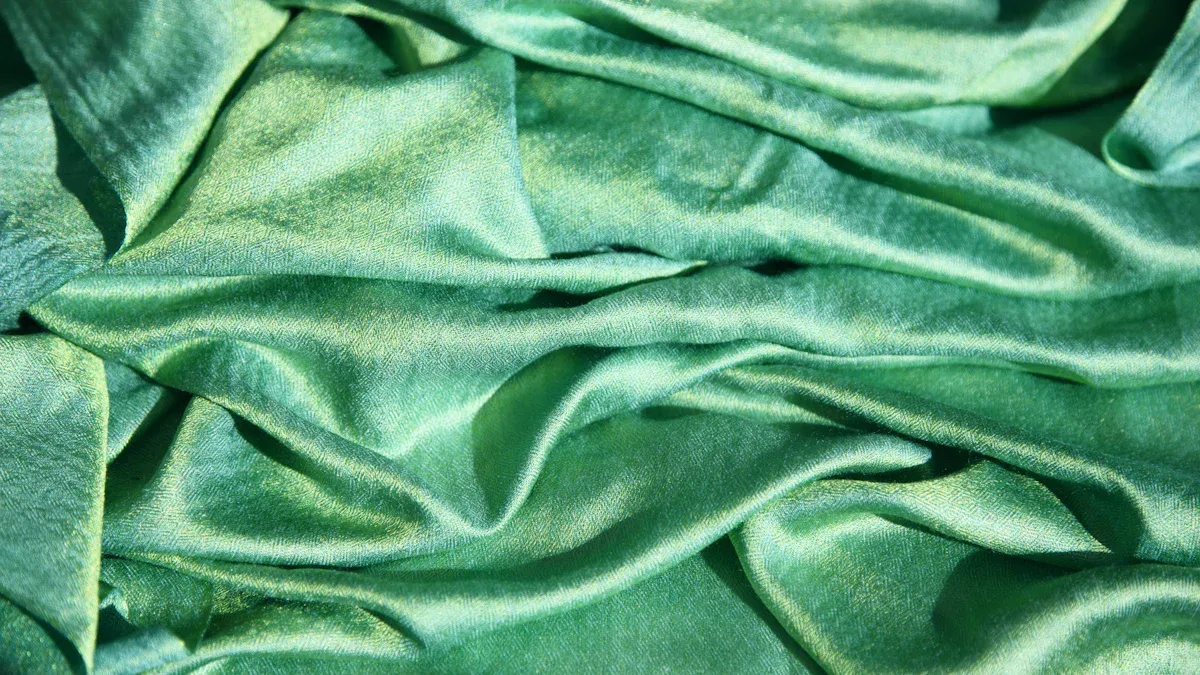
B2B buyers have a big question. How do they pick the best fibers for good knitwear and meet what people want? The answer starts with knowing why traceability and sustainability matter. In the last five years, the global knitwear market has changed:
More people want natural, organic, and recycled fibers.
Luxury brands like Loro Piana use more high-quality materials.
New tech like 3D knitting helps cut waste and make custom Luxury Fibers.
More classic styles now use eco-friendly yarns.
These changes show it is important to balance quality, price, and responsible sourcing when choosing fibers.
Key Takeaways
Picking the best fiber means thinking about quality, price, and the environment. This helps meet what customers want and matches the brand’s values. Luxury fibers like cashmere and alpaca feel soft and last long. But they often need smaller orders and take more time to get. Eco-friendly fibers like organic cotton and TENCEL™ help the planet. They also have trusted labels to show they are sourced the right way. Budget fibers, like synthetics and blends, cost less and are strong. But they can be bad for the environment. Working with certified suppliers and factories keeps quality high and makes tracking easy. This helps brands make knitwear that fits their goals.
Fiber Choice Importance
Cost, MOQ, Lead-Time
Picking the right fiber for knitwear starts with knowing what affects cost and how things are made. Many things change the final price of knitwear:
The price of raw materials, like those used for polyester, can go up and down with oil prices. If you want sustainable or plant-based fibers, you pay more.
Labor costs are not the same everywhere. Factories in Asia usually charge less, but if they follow special labor rules, it can cost more.
Making knitwear also needs energy, machines, and building care. Using eco-friendly ways can make these costs higher.
If you want special colors or finishes, you pay extra for the tools needed.
Checking quality and getting certificates makes sure rules are followed, but it adds more cost.
Shipping and customs can make the total price much higher, especially if the factory is far away.
How much profit the supplier makes depends on how big your order is and who you are. Bigger orders usually get better prices.
Category | Typical MOQ (pieces per style) | Lead-time Characteristics |
|---|---|---|
Luxury Fibers | Longer lead times because they focus on quality and small batches. These often need more work by hand. | |
Budget Fibers | 500 – 5000+ | Shorter lead times because they use simple materials and make lots at once. |
Luxury knitwear usually needs fewer pieces per order and takes longer to make. Budget fibers let you order more at once and get them faster.
Performance & Sustainability
The fiber you pick changes how long the product lasts, how it feels, and how it affects the planet. Luxury fibers like cashmere, silk, and alpaca are very soft and warm. Alpaca is good for people with allergies and is better for the environment. Eco-friendly fibers like organic cotton, linen, hemp, and TENCEL Lyocell break down naturally and are better for the earth. Linen and hemp get softer and stronger as you use them. Synthetic fibers like acrylic and nylon last a long time and cost less, but they are not as good for the environment because they come from fossil fuels. Acrylic is softer than wool and easy to care for. Nylon is very strong but does not feel as nice as natural fibers.
Sustainability certifications help buyers know if fibers are sourced the right way. Programs like Responsible Wool Standard, Global Organic Textile Standard, and Global Recycled Standard set rules for animal care, organic content, and using recycled fibers.
Market Perceptions
What people think about fibers changes what they buy and how they see brands. Many people think luxury fibers mean something special, comfortable, and made the right way. Brands that use certified eco-friendly fibers can attract buyers who care about the planet. Synthetic fibers are cheaper but some people worry about their effect on the environment. Blended yarns mix natural and synthetic fibers to give both comfort and strength at a good price. Brands need to pick fibers that match what their customers care about to keep trust and meet new needs.
Luxury Fibers Overview
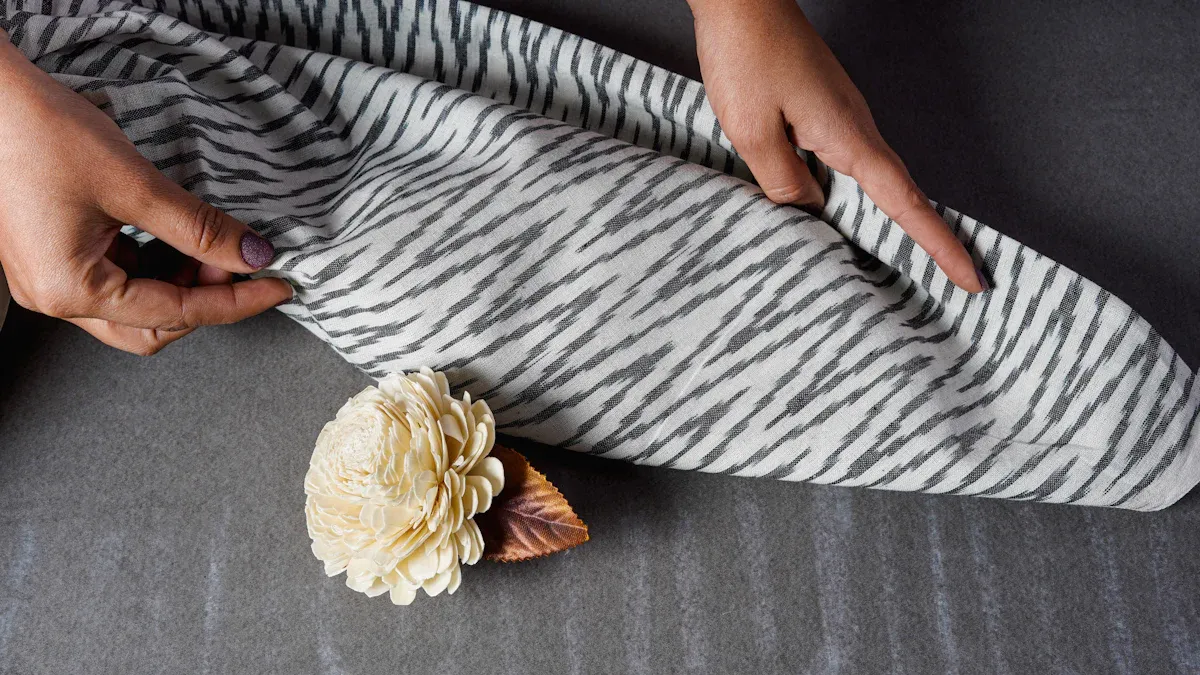
Luxury fibers are used for the best knitwear. These fibers are rare and easy to trace. They have special qualities that make them stand out. Brands and buyers like them because they are soft, warm, and last a long time. Many luxury fibers keep looking and feeling nice after many washes. They do not get fuzzy or pill easily, so clothes last longer. These fibers are also very comfortable. They feel soft and cozy on the skin, even for people with sensitive skin. Certifications like OEKO-TEX and GOTS show these fibers are made safely and help the planet. Luxury fibers can mix with synthetics to make them stronger and better for the environment.
Animal-Based Luxury Fibers
Animal-based luxury fibers are cashmere, mohair, alpaca, angora, and silk. Each one has something special for knitwear.
Cashmere comes from goats in China, Mongolia, and the Middle East. It is famous for being soft and warm. Cashmere is made at certain times of the year by herders who move around. It can be hard to know where it comes from and how much it should cost.
Mohair is mostly made in South Africa, Turkey, and the USA. It is light, strong, and has a fancy look. Mohair does not wear out or get fuzzy fast, so it is good for sweaters and hats. More than half of mohair is used for clothes, and top designers like it for its look and eco-friendly side. Mohair mixes well with other fibers to make them softer and last longer.
Alpaca fiber is soft, warm, and good for people with allergies. It is popular for eco-friendly and high-end knitwear.
Angora and silk are also used in luxury knitwear. Angora is very soft and fluffy. Silk makes clothes shiny and smooth.
Fiber | Global Production Volume (approx.) | Price Range (per pound) | Notes on Production and Market Trends |
|---|---|---|---|
Mohair | $3.40 – $6.37 | South Africa makes the most; fashion trends change the market | |
Cashmere | ~4 million units (likely kg or tons) | Variable | Mostly from China, Mongolia, Middle East; not well organized |
Alpaca | N/A | N/A | Market grows with more focus on eco-friendly and luxury use |
Note: Some places make less mohair now, but South Africa makes more. Cashmere is still made a lot, but it is not well organized, so prices and tracking are hard.
People want to know where animal-based luxury fibers come from. Brands use rules like Responsible Wool Standard, ZQ Merino, and SICTED to check this. New tech like RFID tags and blockchain help track fibers from farms to finished clothes. Laws in the EU and other places help make things clear. Many brands now ask their suppliers to follow these rules. For example, Kering uses blockchain to track most of its cashmere. But there are still problems, like fake certificates and not enough digital tools for small farmers.
Plant & Cellulosic Luxury Fibers
Plant and cellulosic luxury fibers are cotton, flax (linen), and hemp. These fibers are made from plants and are soft, let air through, and last a long time. They are good for clothes worn in warm weather.
Cotton is soft, lets skin breathe, and is easy to wash. It soaks up sweat, so it feels good every day.
Flax (linen) is stronger and stiffer than cotton. It dries fast, so it keeps you cool.
Hemp is long, strong, and fights germs. It does not get moldy and keeps you cool, so it is great for summer knitwear.
Fiber | Type | Key Properties |
|---|---|---|
Cotton | Seed hair | Soft, lets air in, soaks up water, easy to wash |
Flax | Bast (stem) | Strong, crisp, dries fast |
Hemp | Bast (stem) | Long, strong, lasts long, fights germs, does not get moldy |
Abaca | Leaf | Very strong, shiny, does not get damaged by saltwater |
Coir | Husk (coconut) | Strong, rough, does not get damaged by germs or saltwater |
Plant-based luxury fibers are different from animal-based ones. They are lighter, smoother, and let air in better. But they are not as warm as animal fibers. Plant fibers are easier to take care of and better for the planet. Most can go in the washing machine, but animal fibers may need hand washing or dry cleaning. The best fiber depends on the season, how you will use it, and how you want to clean it.
Eco-Friendly Fibers
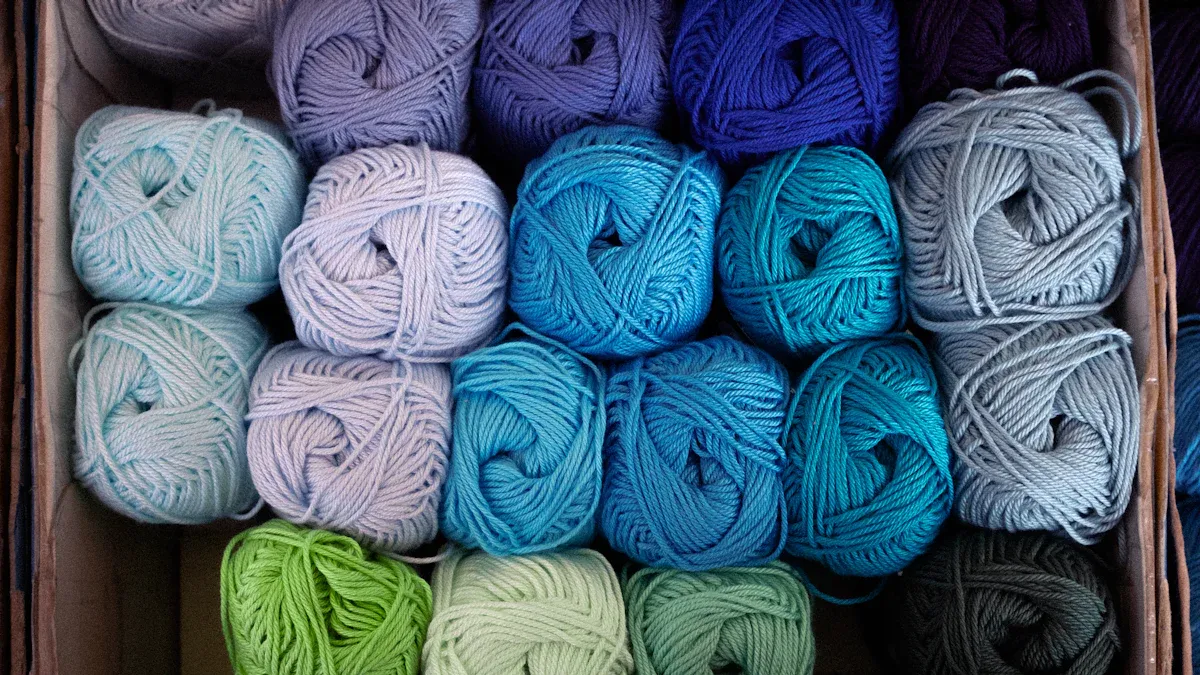
Organic & Recycled Options
Eco-friendly knitwear uses fibers that help the planet. These fibers are made in ways that do not hurt nature. Many B2B buyers pick organic and recycled fibers. They like these because they are easy to track and better for the earth. Some of the most common choices are:
Organic cotton is very popular and often has a GOTS certificate. It grows without bad chemicals and keeps soil healthy.
Hemp, bamboo, linen, soy, modal, lyocell, and silk are organic fibers. They let air in, feel soft, and last a long time.
Recycled polyester and recycled nylon are made from old things like plastic bottles. This helps keep trash out of landfills and saves resources.
Recycled cotton comes from old clothes or leftover fabric. It saves water and energy.
Blended yarns mix organic cotton with hemp or recycled polyester. This makes the yarn work better and be more eco-friendly.
These fibers are used in many types of knitwear. You can find them in single knits, ribs, jacquards, and performance fabrics. Certifications like GOTS and Bluesign show that the fibers are made in a green way. Using dyes that do not harm the earth also helps.
Tip: Always check certifications with trusted groups. This helps you avoid fake eco-friendly claims.
Certification | Focus Area | Importance for Knitwear Fibers |
|---|---|---|
GOTS | Organic fibers, bans toxic chemicals | Makes sure fibers are organic and made the right way |
GRS | Recycled materials, traceability | Proves fibers are recycled and sourced responsibly |
Free from harmful substances | Checks that all parts are safe | |
Bluesign | Environmental impact, non-toxic materials | Supports making textiles in a green way |
Innovative Cellulosics
New cellulosic fibers like TENCEL™ Lyocell and TENCEL™ Modal are changing eco-friendly knitwear. These fibers come from wood pulp, mostly from beech trees. Makers use special closed-loop systems to make them. This means water and solvents are reused, so there is little waste.
Aspect | TENCEL™ Lyocell | TENCEL™ Modal |
|---|---|---|
Source | Wood pulp (beech trees) | Wood pulp (beech trees) |
Production | Closed-loop, minimal waste | Uses more chemicals, still eco-friendly |
Biodegradability | Yes, no microplastic shedding | 100% biodegradable |
Strength | Strong, durable, good for activewear | Softer, ideal for luxury apparel |
Certifications | Multiple, including EU Ecolabel | Multiple, including USDA Biopreferred |
TENCEL™ Modal is known for being very soft and breaking down fully in nature. Both fibers pull sweat away and let skin breathe. This makes them good for luxury and sports knitwear. Lenzing, the main maker, wants to have zero carbon by 2050. These fibers have top certifications like EU Ecolabel and EcoVadis Platinum. This shows they meet high green standards.
Note: Closed-loop systems and trusted certifications help brands reach tough green goals and still give great quality.
Budget Fiber Options
Synthetic Fibers
Synthetic fibers are important for budget knitwear. Factories make these fibers from petrochemicals. This makes them cheaper than most natural fibers. Polyester and acrylic are the most used types. These fibers are strong and do not stain or wrinkle easily. Many brands pick synthetics because they cost less and are simple to wash.
But synthetic fibers have some problems. They do not break down in nature. They can turn into microplastics that hurt the earth. Making these fibers uses fossil fuels and lets out bad chemicals. Synthetic fabrics can also hold in heat and sweat. This makes them less comfy than natural fibers.
Aspect | Synthetic Fibers | Natural Fibers |
|---|---|---|
Cost | Usually cost less | Often cost more |
Durability | Last longer, fight stains and wrinkles | Not as tough, need more care |
Environmental Impact | Not renewable, do not break down, cause microplastic waste | Renewable, break down, better for the earth |
Comfort | Not as airy, can get hot and sweaty | More airy, feel better on skin |
Note: Synthetic fibers save money and are easy to care for, but brands should think about the harm to the planet.
Blended Yarns
Blended yarns mix two or more fibers to save money and give comfort. Cotton-acrylic blends are a top pick for budget knitwear. These blends feel soft like cotton and are strong like acrylic. They do not wrinkle, shrink, or tear fast. This makes them good for daily clothes.
Advantages of blended yarns:
Clothes last longer and stay strong.
Cost less than pure cotton or wool.
Feel soft, warm, and bend easily for many styles.
Simple to wash, dry fast, and keep bright colors.
Disadvantages:
Do not let air or sweat through as well as pure cotton.
Acrylic can make them less comfy in hot weather.
Blended yarns help brands make knitwear that is not too costly. They are a smart choice for buyers who want good value and nice looks.
Strategic Blends
Luxury & Performance Mixes
Strategic blends mix natural and synthetic fibers in knitwear. Brands often use wool, cashmere, alpaca, or silk with synthetics like elastane, nylon, or polyester. These blends make knitwear soft and warm. They also help it stretch, last longer, and dry fast. Many brands now use recycled or plant-based elastane, like Hyosung’s regen BIO Elastane. This adds stretch and helps the planet.
Some popular blends are:
Wool or cashmere with elastane for more stretch and comfort.
Alpaca or silk with nylon for strength and a smooth look.
Recycled polyester with natural fibers for better moisture control and longer wear.
These blends can cool or warm you, fight bad smells, and feel natural. Stretchy fibers that feel like cotton make clothes fit better and feel nice. Blends with recycled polyester or nylon help brands make luxury sportswear and athleisure. They give style, comfort, and help the environment.
Note: Mixing fibers lets brands make new styles and better clothes. This helps them meet what buyers want.
Cost-Effective Blends
Cost-effective blends help brands make good knitwear for less money. Recycled cotton-polyester blends are a top choice. These blends keep knitwear soft, strong, and warm. They also use less new material. Using recycled yarn saves energy and keeps trash out of landfills. This helps circular fashion.
Main benefits of cost-effective blends are:
Lower costs to make knitwear but still good quality.
Knitwear that lasts long and feels comfy.
Many colors and textures for fun designs.
Better for the planet and less harm to nature.
Brands can sometimes charge more for eco-friendly knitwear made from recycled blends. These products are popular with people who want green fashion. Cost-effective blends also fit with circular fashion. This means clothes can be recycled when they are old.
Rare & Experimental Fibers
Qiviut & Possum Down
Some of the rarest fibers come from special animals. Qiviut and possum down are known for being warm and soft. These fibers are hard to find and make, so they are used in luxury knitwear.
Fiber | Source Animal | Defining Characteristics | Market Availability & Usage |
|---|---|---|---|
Qiviut | Musk Ox (Arctic) | Extremely warm (8x warmer than wool), durable, soft undercoat, shed in spring, variety of brown hues | Rare, expensive, not commonly found in commercial yarns, considered luxury fiber, best for small accessories |
Possum Down | Brushtail Possum (NZ) | Short, fine fibers, soft, lightweight, warmer than wool, difficult to spin, cannot be dyed (natural brown color) | Limited availability, usually blended with merino wool, rare and expensive, best for small accessories, prone to shedding and haloing |
Qiviut comes from the soft fur under musk oxen. It is very warm and soft. People use qiviut yarn for small things like hats and scarves. Possum down comes from brushtail possums in New Zealand. It is light, warm, and feels silky. Spinners often mix possum down with merino wool. This makes the yarn stronger and helps it shed less. Both fibers are rare and cost a lot. Brands use them for special, small-batch items.
Note: Using possum down also helps New Zealand by controlling a pest animal.
SeaCell™ & Milk Fiber
SeaCell™ and milk fiber are new and different fibers. They use special ways and materials to make yarn.
SeaCell™ is made from seaweed and wood pulp. The yarn feels soft and smooth, almost like silk. SeaCell™ lets skin breathe and has minerals that are good for you. It also fights germs and blocks UV rays. This makes it good for eco-friendly clothes. But making SeaCell™ uses chemicals that can hurt the environment. Most of the plants used grow fast or are waste, so this helps nature.
Milk fiber is made from the protein in milk. It acts like a plant fiber. Milk fiber is shiny, soft, and fights germs. It soaks up sweat and keeps skin dry. People use it for underwear, sportswear, and baby clothes. Spinners need to be careful when working with milk fiber. The yarn also needs special dye and care.
SeaCell™ Highlights:
Soft, lets skin breathe, and feels nice
Fights germs and blocks UV rays
Made from seaweed and wood pulp
Milk Fiber Highlights:
Protein-based, shiny, and soft
Fights germs and soaks up sweat
Great for clothes worn close to skin
These rare and new fibers give brands more choices for special and unique knitwear.
Sourcing Strategies
Picking the right supplier is very important for knitwear projects. Buyers should choose partners who are open, make good products, and care about the planet. Top suppliers often have certifications like GOTS, Fair Trade, or Responsible Wool Standard. These show the supplier uses fair and green methods.
Key criteria for supplier selection include:
Knowing about fiber types like cotton, wool, silk, linen, hemp, and bamboo. Each fiber has special traits like letting air in, lasting long, or being better for nature.
Checking how the fabric works, like if it pills or soaks up water. If fabric does not pill, clothes look new longer. Cotton and other natural fibers soak up sweat, so they feel comfy.
Looking at the supplier’s history for making good products and using fair ways to get fibers.
Making sure the supplier is honest about where fibers come from. Digital tools like blockchain or live tracking can help.
Tip: Working with the same supplier for a long time helps brands get better at being green and always improving.
Quality control starts when picking raw materials. Buyers should check fiber length, strength, and how fine it is with tests. Getting fibers to the same wetness helps mix them and stops static. Machines that are set right and sensors that check quality help keep things the same. Keeping machines in good shape and teaching workers also keeps standards high.
Best practices for traceability and quality control:
Check new raw materials for problems and strength.
Watch the making process with checks like color and seam tests.
Test finished clothes for shrinking, pilling, and leftover chemicals.
Use digital systems to get feedback and track products right away.
Ask for proof of certifications and keep records for each batch.
To balance cost, quality, and being green, buyers need clear goals. They should pick suppliers who save water and energy and use safe dyes. Always trying to get better, using feedback and green scores, helps brands do well in knitwear sourcing.
Decision Matrix
Brand Alignment
Each brand has its own story and values. The fibers a brand picks should match these values. This helps buyers trust the brand. Luxury brands often use rare fibers like cashmere or silk. These fibers show that the brand is high quality and special. Brands that care about the planet pick organic cotton, TENCEL™, or recycled blends. These fibers help the earth and attract people who want green products.
A decision matrix is a simple tool. It helps teams match fibers to what the brand stands for. Teams can give each fiber a score for important things:
Fiber Type | Luxury Appeal | Sustainability | Traceability | Market Demand |
|---|---|---|---|---|
Cashmere | 5 | 3 | 3 | 5 |
Organic Cotton | 3 | 5 | 4 | 4 |
Recycled Polyester | 2 | 4 | 4 | 3 |
TENCEL™ Lyocell | 4 | 5 | 5 | 4 |
Tip: Brands should look at their mission statement before picking fibers. This makes sure every choice matches what the brand promises.
Budget Considerations
How much fibers cost is very important. Teams need to think about quality, price, and being green. Some fibers, like qiviut or pure silk, are much more expensive than blends or synthetics. High minimum order amounts and long wait times can also make things cost more.
A checklist can help buyers compare their choices:
Write down all fiber options and their price per kilogram.
Check the minimum order and wait time for each supplier.
Add up all costs, including shipping and certification.
See if the fiber meets both quality and green goals.
Brands that check these things can avoid surprise costs and delays. They can also get better deals from suppliers.
A clear decision matrix helps teams feel sure. It lets them pick fibers that fit the brand’s goals and the project’s budget.
Factory Support
Custom Sourcing
Factories help brands make special knitwear. Many top factories give lots of custom sourcing help. They guide brands to pick the best fibers, colors, and patterns. Design teams and buyers work together to choose colors and patterns that fit the brand. Factories make samples so brands can see and touch them before making more. This step checks if the fit, fabric, and quality are right.
Factories often get high-quality and green fibers. They can offer cashmere, Merino wool, alpaca, Lyocell, and organic cotton that are sourced the right way. Special knitting methods like jacquard knitting, hand-crochet, and printing let brands make creative designs. Factories also help with private labels, matching colors, making patterns, sizing, and packaging. These services help brands be different from others.
Tip: Brands that work closely with factories can make products that show their values and meet what customers want.
Quality Assurance
Quality assurance makes sure every item is made well. Top factories use strong quality checks at every step. They look at raw materials, watch the making process, and check finished items. This helps brands stop mistakes and keep a good name.
Many factories have top green certifications. These include GOTS, OEKO-TEX 100, and ISO 45001. Some factories, like Bryden Apparel and Billoomi Fashion, care about fair work and do regular checks. Others, like Create Fashion Brand in Portugal, use solar power and recycle all waste. S&F Garment Manufacturing in Bali uses green materials and helps local people.
Factory Name | Location | Certifications & Practices | Labor Practices | Eco-Friendly Highlights |
|---|---|---|---|---|
Bryden Apparel | Singapore/Asia | GOTS, OEKO-TEX 100 | Personal audits | Organic manufacturing, safety testing |
Billoomi Fashion | India | GOTS, OEKO-TEX 100 | SEDEX, regular audits | Fair wages, ethical supply chain |
Create Fashion Brand | Portugal | GOTS, OEKO-TEX 100, ISO 45001 | Zero waste manufacturing | Solar energy, recycling, water savings |
S&F Garment Manufacturing | Bali, Indonesia | GOTS, recycled fibers | Certified safe environment | Environmental compliance |
Factories that focus on quality and being green help brands give trusted, high-value knitwear to buyers.
B2B buyers can make good choices by using simple steps:
Pick fabrics that fit how the product will be used, like strong knits for sports clothes or fancy ones for luxury items.
Look at what fibers are in the fabric, how it is woven, and if the color looks the same everywhere to check quality.
Talk often with factories to get the right colors and dyes.
Choose eco-friendly options that work well and match what the brand wants.
Use facts from the market and details like GSM and yarn count to help decide.
Ask expert suppliers for advice or get samples you can track to feel sure about your pick.
FAQ
What are the most popular luxury fibers for knitwear?
Cashmere, alpaca, mohair, silk, and fine Merino wool are top choices. These fibers feel soft and keep you warm. They also last a long time. Many brands use them for their best clothes.
How can buyers verify fiber sustainability claims?
Buyers should ask for certifications like GOTS, OEKO-TEX, or Responsible Wool Standard.
Tip: Always check the certification number with the group that gave it to make sure it is real.
Do blended yarns affect product quality?
Blended yarns can make clothes stronger and more comfortable. They often mix natural and synthetic fibers.
Benefit | Example |
|---|---|
Strength | Cotton-Polyester |
Softness | Wool-Acrylic |
What is the typical lead time for luxury fiber knitwear?
Luxury fiber knitwear usually takes 8 to 16 weeks to make. Small orders or special designs can take even longer.



